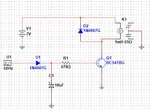CutieJocelyn
Newbie level 4
Hello,
In transmission circuit were using a 5V relay that has Contact DC Max Rating R Load of 3A@24VDC for the conversion of the pulse into a DC voltage. Were having a problem in triggering all the relays with a supply of 9V battery, we also tried to use a AC-DC supply using 7V input but it triggered only some of the relay. Is there any suggestion for the supply that can trigger all the relays? We're using a total of 24 relays. The model of relay that we used was UASH105D.
In transmission circuit were using a 5V relay that has Contact DC Max Rating R Load of 3A@24VDC for the conversion of the pulse into a DC voltage. Were having a problem in triggering all the relays with a supply of 9V battery, we also tried to use a AC-DC supply using 7V input but it triggered only some of the relay. Is there any suggestion for the supply that can trigger all the relays? We're using a total of 24 relays. The model of relay that we used was UASH105D.
